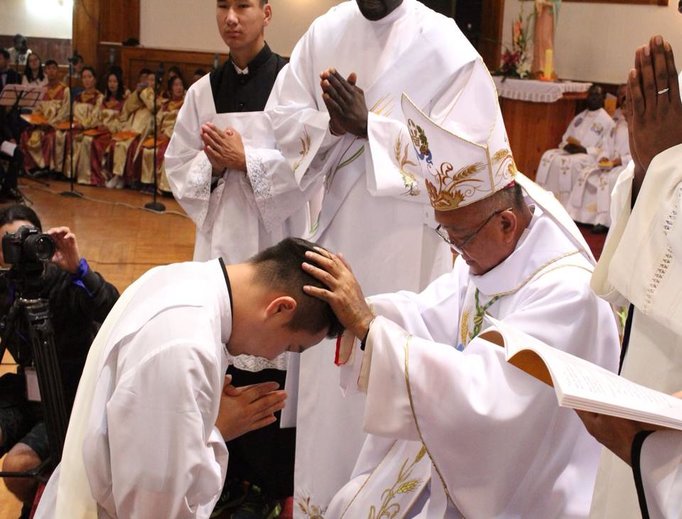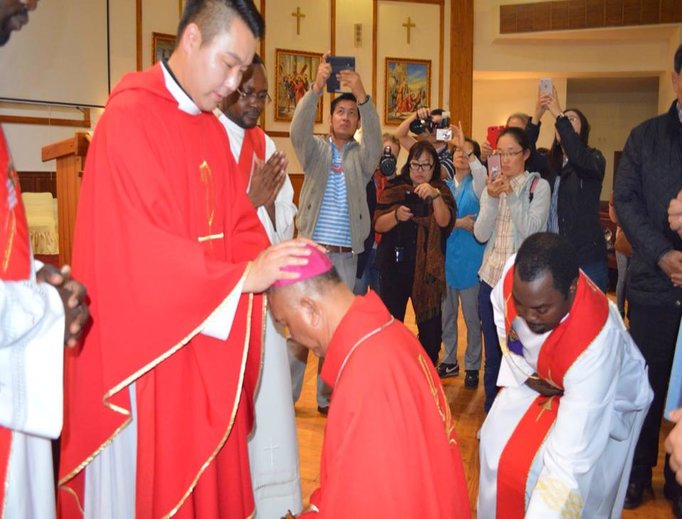Formerly Communist Mongolia Gets Its First Native Priest in History
Bishop Wenceslao Selga Padilla recalls good news of missionary work and the ordination of the first native Mongolian priest this summer.

ULAANBAATAAR, Mongolia — A rare flower has bloomed in the cold, empty deserts through which once thundered the marauding hordes of Genghis Khan.
Mongolia is an enormous landlocked country caught between the two rapacious superpowers, China and Russia, both of which still vie for influence, if not outright control, there.
In addition, temperature extremes range from -40ºF to 104ºF, which might explain Genghis Khan's temperament and his eagerness to leave the country of his birth.
Now, in the wake of the spiritual and economic desolation wrought in the name of communism, shines a bright light.
Bishop Wenceslao Selga Padilla, apostolic prefect of Mongolia, spoke to the Register about his amazing success toiling in the Lord’s vineyards of Central Asia for 24 years. He originally came with two others missionaries, Fathers Gilbert Sales and Robert Goessens, to Mongolia on July 10, 1992.
Bishop Padilla, a native of the Philippines, belongs to the CICM Missionaries (Latin: Congregatio Immaculati Cordis Mariae, or the Congregation of the Immaculate Heart of Mary). This men’s missionary religious congregation was established in 1862 by the Belgian priest Father Theophiel Verbist (1823-1868) in Scheut, Anderlecht, a suburb of Brussels.
The congregation is responsible for missionary projects in China, Mongolia, the Philippines and Democratic Republic of the Congo. The community is informally known as Missionhurst.
The Catholic Church in Mongolia currently has 1,300 baptized faithful ― this represents .04% of the total population of less than 3 million. This fledgling community is cared for by 70 missionaries ― 22 men and 48 religious sisters ― from 22 countries and 12 different congregations. In addition, five lay missionaries/volunteers assist the Catholic mission there.
“This is really the face of the universal Church that is helping to build the kingdom of God in Mongolia. Foreign missionaries demonstrate a mosaic of races, colors and languages,” the bishop said.
A mere 22 years ago, when Mongolia only had 2 million people spread across 604,600 miles (almost three times the area of Texas), it had zero native Catholics.
“The Catholic community in Mongolia grows by about 20 new souls every year,” Bishop Padilla said.
The first Mongolian child that Bishop Padilla baptized is now a practicing lawyer and the secretary for the Church community.
According to the bishop, there are 1,300 native Catholics in his care.
When the missionaries arrived in Mongolia, “There were basically no native Catholics, but the people were searching,” said Bishop Padilla.
The spiritual emptiness to which the bishop referred is a result of nearly a century of brutally enforced Soviet secularism that was antithetical to religion. “The people continue to have an implicit desire for God. They are starting to feel a curiosity towards believers,” Bishop Padilla explained. “To those who ask for information about us, we say: ‘Come, and you will see.’ Those who wish to become a Christian begin a catechumenal path that lasts two years.”
Catholic History
Roman Catholicism was first introduced to Mongolia by 13th-century Franciscan friars William Rubruck and Giovanni da Pian del Carpine.
In 1307, Pope Clement V made Friar John of Montecorvino the archbishop of Peking. He was a key missionary to Mongol-controlled China during the Yuan Dynasty. The Franciscan was the first to translate the New Testament and the Psalms into Mongolian. He became responsible for all of Outer Mongolia as well as China. However, the missions died out with the destruction of Kublai Khan’s Yuan Dynasty in 1368.
Catholic missionaries once again entered this otherwise inhospitable land only after the Second Opium War in the mid-19th century. However, this mission, once again, closed a year after a Soviet-sponsored communist invasion in the early part of the 20th century.
In 1838, the apostolic vicariate of Liao-tung was separated from the Diocese of Peking. It included both Manchuria and Mongolia. Emmanuel-Jean-François-Verrolles, of the Paris Missions Etrangeres, was the first apostolic vicar.
With the collapse of communism in 1991, Roman Catholic missionaries returned, rebuilt the local Church from scratch and established diplomatic relations between the Vatican and Mongolia.
In 2016, Pope Francis established an apostolic prefecture in Mongolia, with Bishop Padilla in charge.
Bringing Mercy
Whenever Catholic missionaries go far afield, they first work to gain the goodwill of the people to whom they hope to minister through acts of mercy. This introduces them as 1) trustworthy people and 2) a means by which to explain the mission of all Christians ― divinely inspired altruism. The first outreach program of the Catholic Church in Ulaanbaatar was to the city’s street children, who were living in the city’s sewer system ― a place of relative warmth in Mongolia’s brutal winters.
Outside of the city, among the pastoralists, Bishop Padilla has overseen the digging of a series of public wells and offers water free of charge to farmers and nomads. And, as they wait for their animals to have their fill, the natural curiosity of the Mongols, unaccustomed to the presence of foreigners, brings them to ask their generous hosts what they’re doing there.
Once a trough is built, it becomes a focal point for passersby. Once their trust is gained, the diocese starts adding other services, including clinics, veterinarian services and schools.
As Buddhism is the principle religion upon which Mongolian culture is based, Bishop Padilla made sure he introduced himself and explained his intentions.
“One of the first things we did when we arrived in Mongolia was to visit the Buddhist authorities. We assured them that we aren’t a threat to their religion. Up to now, we have good relations with them, and we strengthen this with interfaith and interreligious dialogue. Yearly, on the occasion of the International Day of Peace (Sept. 21) we come together with other representatives of other religions to do prayers for peace. I observe cordial friendship/relations to the heads of the dominant [Buddhist] monasteries/religions/churches in Ulaanbaatar.”
The political situation in Mongolia, a remnant of nearly a century of totalitarian communism and many millennia of Chinese colonialism, has created a toxic political brew that has caused some problems with local leaders.
“Restrictions on visa permission is governed by a quota system,” explained the prelate. “The present system stipulates that for every 30 foreign missionaries/workers, 70 locals should be employed. Sometimes religions are suspect. The good we do is suspected to convert people to our religion.”
Even though Ulaanbaatar isn’t a diocese, Bishop Padilla is incredibly busy.
“We have six parishes: three in Ulaanbaatar and an additional three in other Mongolian cities. In addition, we have five sub-parishes, which don’t have resident priests.”
Following St. Francis’ Example
“We preach with actions,” explained Bishop Padilla. “We proclaim the Gospel in our daily lives, which is how St. Francis of Assisi taught. The Church in Mongolia has established over 25 social and charity institutes, centers and initiatives. We are present on the outskirts of cities, close to the marginalized, the poor and the suffering.”
The Catholic community of Ulaanbaatar has established many socio-developmental, humanitarian and charitable projects and education works/institutions, including:
- two centers that have rescued 120 street children
- homes for elderly men and women
- five Montessori kindergartens
- three primary schools
- a center for 100 children with disabilities and special needs
- a technical school for young adults
- two libraries with study halls and computer facilities
- a women’s dorm for university students, equipped with a study hall and computer/internet facilities
- youth activity centers
- two agricultural farms with community-building programs
- St. Mary’s Clinic, an outpatient clinic with a medical laboratory
- Mostaert Research Center
- Campus ministry center at the University of Ulaanbaatar
- three soup kitchens
- language programs
- pastoral programs to combat alcoholism and physical abuse
- Caritas-Mongolia, which digs and restores wells, home industry, sustainable agriculture and food security, as well as works to stop human trafficking and engages in relief services in the countryside
- retreat center
- social centers with poverty-alleviation programs
- nationwide scholarship program for poor but deserving students from the cities and countryside
Secularism and materialism pose more problems than does the dominant, indigenous Buddhist culture of the lamas.
“We’ve had no problematic encounters yet. Foreign missionaries, a mosaic of races, colors and languages, face no restrictions,” explained Bishop Padilla, “although some question our motives. Most of the young people don’t have any religious affiliation. The people are lured by materialism and consumerism, since the society embraced market economy. They are attracted by the sophistication of affluent societies/countries.”
First Mongolian Priest
But the extraordinary success at converting the Mongolians to Christ’s Church isn’t the only reason for the local community to celebrate.
Joseph Enkh-Baatar, the first native Mongolian priest, was ordained on Aug. 28 in Ulaanbaatar. He celebrated his first Mass in the Cathedral of Sts. Peter and Paul in Ulaanbaatar the same day.

“Father Joseph is a fine man, very talented,” said the bishop, “a humble and gentle person. He’s polite and respectful. He’s a man of service ― always alert to serve, to whomever and wherever [is required of him.]”
Bishop Padilla spoke of the new priest’s family, too.
“Catholicism/Christianity in Mongolia was new when we arrived. The people whom we met were curious as to who we were and what we do. We invited people to be free in meeting with us and joining in our activities, especially our liturgies. Father Joseph’s two elder sisters were among these curious people. [He was 6 years old at the time.] He started attending Mass with his sisters. After a year of preparation/doctrine classes, he and his sisters were baptized. When Joseph entered university [where he studied] biotechnology, he stayed with our CICM fathers at the Sts. Peter and Paul parish in Seoul, Korea. It was there he became attracted to the priesthood. After his graduation, he enrolled at the seminary of Daejeon, Korea. After seven years of formation, he was ordained deacon. After more than a year as a deacon, he was ordained a presbyter on Aug. 28.”
In addition to Father Joseph, the Mongolian community is looking forward to an additional ordination of a seminarian who is in his fourth year of studies. If all goes to plan, he’ll be ordained in three years. Another Catholic Mongolian has just entered the minor seminary, as well.
Bishop Padilla also shared a poignant anecdote about his new priest.
“Some days before Father Joseph’s ordination, a big photo of Joseph was placed at the cathedral’s front wall. There were some kids playing in front of the church. One of them quipped, ‘He’s someone who just died!’ Hearing this, I took it as a lead idea for my homily during the ordination Mass: Christ’s command that we must deny ourselves and take up our crosses daily and follow him (Luke 9:23) jibed perfectly to the child’s comment. Being ordained is dying to Christ, isn’t it?”
As Bishop Padilla remarked of the ordination, “I was caught in amazement/bewilderment. I see it as God’s benevolent visitation to his people. He has again blest and gifted his people, the Mongolian nation.”
Register correspondent Angelo Stagnaro writes from New York.
INFORMATION
Catholic Church Mission
Apostolic Prefecture of Ulaanbaatar
P.O. Box 694
Ulaanbaatar, Mongolia
















